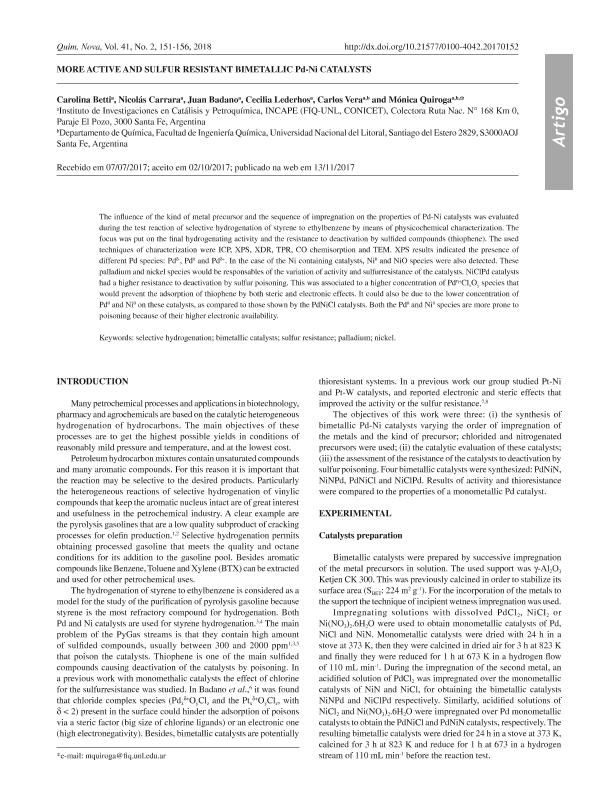Artículo
More active and sulfur resistant bimetallic Pd-Ni catalysts
Betti, Carolina Paola ; Carrara, Nicolás Ricardo
; Carrara, Nicolás Ricardo ; Badano, Juan Manuel
; Badano, Juan Manuel ; Lederhos, Cecilia Rosa
; Lederhos, Cecilia Rosa ; Vera, Carlos Roman
; Vera, Carlos Roman ; Quiroga, Monica Esther
; Quiroga, Monica Esther
 ; Carrara, Nicolás Ricardo
; Carrara, Nicolás Ricardo ; Badano, Juan Manuel
; Badano, Juan Manuel ; Lederhos, Cecilia Rosa
; Lederhos, Cecilia Rosa ; Vera, Carlos Roman
; Vera, Carlos Roman ; Quiroga, Monica Esther
; Quiroga, Monica Esther
Fecha de publicación:
02/2018
Editorial:
Sociedade Brasileira de Química
Revista:
Química Nova
ISSN:
0100-4042
Idioma:
Inglés
Tipo de recurso:
Artículo publicado
Clasificación temática:
Resumen
The influence of the kind of metal precursor and the sequence of impregnation on the properties of Pd-Ni catalysts was evaluated during the test reaction of selective hydrogenation of styrene to ethylbenzene by means of physicochemical characterization. The focus was put on the final hydrogenating activity and the resistance to deactivation by sulfided compounds (thiophene). The used techniques of characterization were ICP, XPS, XDR, TPR, CO chemisorption and TEM. XPS results indicated the presence of different Pd species: Pdδ-, Pd0 and Pdδ+. In the case of the Ni containing catalysts, Ni0 and NiO species were also detected. These palladium and nickel species would be responsables of the variation of activity and sulfurresistance of the catalysts. NiClPd catalysts had a higher resistance to deactivation by sulfur poisoning. This was associated to a higher concentration of Pdn+ClxOy species that would prevent the adsorption of thiophene by both steric and electronic effects. It could also be due to the lower concentration of Pd0 and Ni0 on these catalysts, as compared to those shown by the PdNiCl catalysts. Both the Pd0 and Ni0 species are more prone to poisoning because of their higher electronic availability.
Archivos asociados
Licencia
Identificadores
Colecciones
Articulos(INCAPE)
Articulos de INST.DE INVEST.EN CATALISIS Y PETROQUIMICA "ING. JOSE MIGUEL PARERA"
Articulos de INST.DE INVEST.EN CATALISIS Y PETROQUIMICA "ING. JOSE MIGUEL PARERA"
Citación
Betti, Carolina Paola; Carrara, Nicolás Ricardo; Badano, Juan Manuel; Lederhos, Cecilia Rosa; Vera, Carlos Roman; et al.; More active and sulfur resistant bimetallic Pd-Ni catalysts; Sociedade Brasileira de Química; Química Nova; 41; 2; 2-2018; 151-156
Compartir
Altmétricas



